Hey! Don’t Trash This Museum!
Hartford (Google Maps Location)
September 27, 2007
This museum closed in the summer of 2016.
I’m often asked where my love of writing came from. My answer is always the same – “I have no idea.” I have a much easier time answering where my love of travel and exploration came from – my dad. While he’ll be the first to admit that he wasn’t the perfect dad all the time, he’ll also be the first to brag that he took us around the country and back several times. I had a childhood fortunate enough to visit about 15 National Parks from Acadia to Yosemite, from Glacier to Carlsbad.
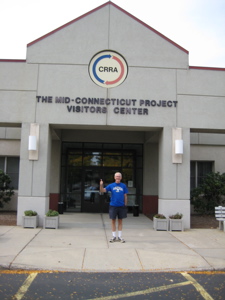
My dad
Along the way, I was also dragged – usually against my will – to a bunch of “boring old museums.” I recall days around Washington DC, at Mt. Vernon, or hours wasted at some dusty old fort in Kansas. It goes without saying that those experiences jelled somehow into what I am today – and also what I plan on doing with (to?) my children.
On one of my parents’f visits to Connecticut, I decided to begin paying back my dear old dad – one museum at a time. “And what better museum,” I thought, “than the trash museum?” Indeed. It may sound strange, but my father has a close relationship with trash and recycling. Perhaps because he spent his working life trying to come up with ways to “recycle” the byproducts of the refining process or maybe he’s just cheap like me and appreciates all the nickels people like to throw on the ground.
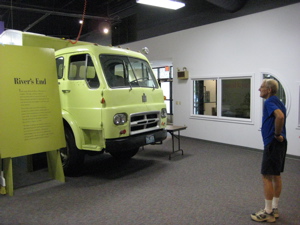
He instilled in me an appreciation for both recycling AND the dollar back when I was a kid. I had to raise half my ticket to Australia when I was 15 so in order to supplement my paperboy income, I began collecting recyclables. I had the entire neighborhood saving papers for me and we used to scour half of the entire University of Delaware stadium (19,000 seats) and parking lot after games for cans and bottles. We’d take this stuff to the junkyard and I’d walk away with about fifty more bucks every month or so. Easy money.
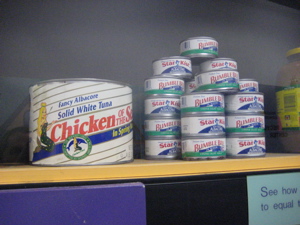
Well, I did go to Australia when I was 15 thanks to trash. I still collect cans and bottles to this very day when I hike, when I’m alone in a parking lot, whatever. I don’t care. I’m cleaning up my world and I’m making a few bucks here and there. So, what better museum for my pops and I to enjoy together than the CRRA Trash Museum?
“CRRA” stands for “Connecticut Resources Recovery Authority” which oversees the operation of the four trash-to-energy plants in Hartford, Bridgeport, Wallingford and Preston. (There are 6 in CT altogether, which process more than 2 million tons of municipal solid waste – that’s 82% of the state’s post-recycled trash.) About two of every three cities in CT send their trash to a CRRA plant. In 2004, the four plants generated 1.1 billion kilowatt hours of Class II green power, which sounds like a lot to me.
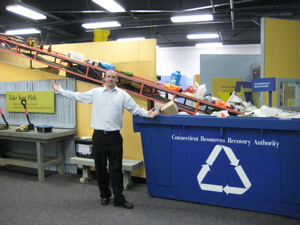
I sped up I-91 from work to meet my dad for “lunch.” The museum is situated very near a recycling center and is actually part of Hartford’s trash-to-energy plant. Amazingly, we were the only guests there at the time.
We entered and were greeted by two very friendly women who were excited to tell us about the museum. It’s basically one big room, divided up by artistic trash piles and a viewing platform. “Viewing what?” Viewing people sort our trash, that’s what. And let me tell you – that’s some good viewing right there.
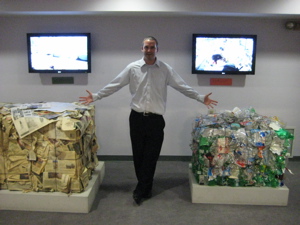
I should note that the CRRA has a mascot: Phillup D. Bag. No joke. And the first thing you see upon entering the museum is the “Temple of Trash.” Awesome. (Actually, it is pretty awesome… Just a massive stuck-together pile of trash molded into a welcoming archway.) Awww, that’s nice.
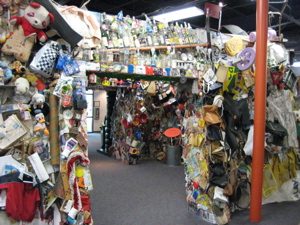
l’Arc de Garbage
We then learned about the history of trash around the world and in the US. Facts like how pigs ran wild in city streets in the 1800’s, eating everyone’s refuse. And how the aluminum can for drinks was invented in 1963. And that Fresh Kills landfill on Staten Island opened in 1948 – which today is the only manmade thing other than the Great Wall of China that can be seen from space.
I could go on all day – but there were trash sculptures to see! A 4 foot tall lighthouse made from aluminum cans, Gatorade bottles and bubble wrap! The Colt Building cobbled together from junk, and the Aetna building from other assorted trash.
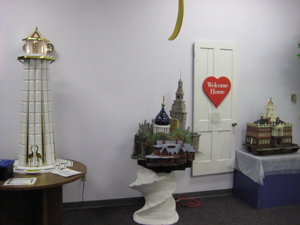
Up next was a nice composting display – explaining the benefits of it and how to do it. We quickly checked out the kid’s area – which is relatively large. In fact, we learned quickly that the Trash Museum caters to kids. Sounds kind of silly, being trashy and all, but it’s true – and they do a good job with it. I envision hordes of Cub Scouts scampering through this place every weekend.
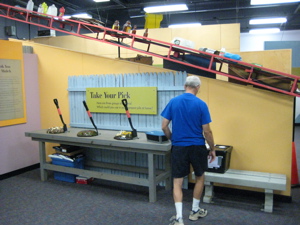
My pops checking out what’s inside the composting bin…
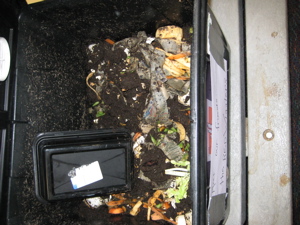
Honest to goodness dirt.
There are several little educational sections to the museum. I learned all about how aluminum is mined and utilized – in case you didn’t know, aluminum is the most abundant metal in the Earth’s crust, and the third most abundant element overall, after oxygen and silicon. It makes up about 8% by weight of the Earth’s solid surface.
There is a cool diagram of how the trash-to-energy plant works; in short it’s: Trash, sort, shred, process, pack, burn, turbine, heat, gas scrubber, filter, stack. That’s all you need to know – my dad, being my dad, really wanted to learn how it all worked and lamented that his home state doesn’t have a similar energy initiative. If this is so progressive and offers such savings, why do we in CT pay the highest electricity rates in the entire continental US? Ahhh, Connecticut.
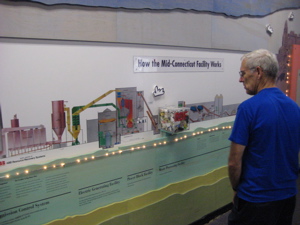
Finally, on to the viewing area! There is something slightly uncomfortable about standing in an enclosed space with giant windows looking down upon my fellow man sorting trash for a living. I felt this way back in Tillamook, OR watching people make cheese too… I just put myself in their position and can’t imagine people watching me work. And since they think we’re most likely looking down on their job, it’s all the worse.
Taking a bunch of pictures is even worse, trust me.
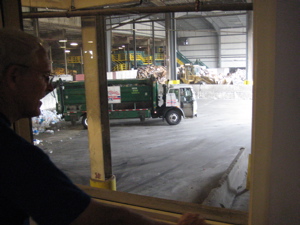
Oooh, the truck dumps trash there…
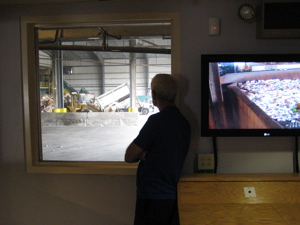
Then the people sort the trash there…
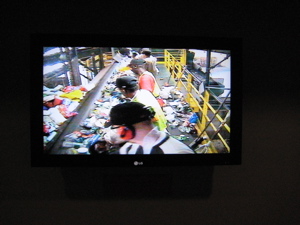
As cool as it was watching through the windows, the close-up closed-circuit live screen action was even better.
And yet, there’s something appealing about sorting recyclables to my mind. Watching the pros do it was somehow mesmerizing. My dad and I shared a bonding moment up there, watching other fathers and other sons separate empty ketchup bottles from glossy magazines. We watched for about ten minutes.
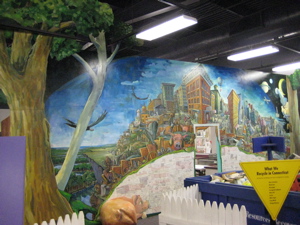
This is called the History of Trash Mural, by Ted Essestyn
For you readers, here’s what CAN’T be recycled; but people seem to put them in their blue bins – oil, that old shiny smooth office paper, scrap metal, batteries, styrofoam, and phone books. My dad explained about the office paper – something about clay in it because of some “kayilin” process, but as you can tell, I have no idea what that was all about. Ask my dad. (*I did – “The clay is kaolin which is an aluminum silicate,” says he.)
Before we left, the nice ladies gave me a trash hat for my son and were thrilled that we had a good time in their trashy museum. My dad and I left knowing that trash had once again brought us closer together. The best part? CT still has a Garbage Museum in Stratford to look forward to! (Which we visited… and which is also now closed.)
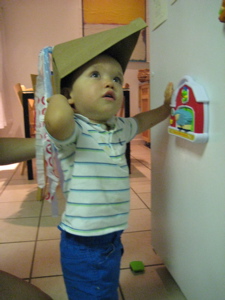
Trash hat! Trash hat! Who’s got a trash hat!

 honeybunny says
honeybunny says
November 25, 2007 at 3:44 pmYour Dad has nice legs.
just saying.
hb
 Rizzle says
Rizzle says
May 5, 2008 at 6:57 amNICE JOB ON THE INFORMATION YOUR PROVIDING US WITH AN WITH PICTURES ALSO
 Mrs. Golia says
Mrs. Golia says
March 30, 2009 at 7:31 amHi, my name is Jessica and I’m a student at Totoket Valley Elementary School.I would like to ask you if you would like to give my class a brochure or two for our Eco Fair that is coming up soon. My class is doing a booth on where our recycleing goes. So if you have any information on that we would be very happy, and thank you!
 janet thivierge says
janet thivierge says
October 2, 2010 at 8:56 pmI visited with my grandchildren. They had been another time and so wanted to share this experience with me. Interesting, an eye opener, and educational.
 Rich Braham says
Rich Braham says
April 18, 2011 at 11:44 pmActually, phone books are allowed in recycle bins here in Florida where I live. That hasn’t always been the case but they really encourage it now. Maybe they’ve changed it up there too.
 Pamela F. Garry says
Pamela F. Garry says
November 1, 2013 at 12:51 pmThanks for sharing so much information and enthusiasm about the CRRA Trash Museum in Hartford, CT. It is a great place to learn about all aspects of waste management, to see a state-of-the-art single-stream recycling center live and upclose, and it offers fun activities for visitors of all ages. The cost is $4 per person and children younger than 2 are no cost. Public hours are Wednesdays through Fridays from 12 noon to 4:00 P.M. Check about special hours during school vacations. Additional times are available for pre-registered group tours. Learn more at http://www.crra.org; on Facebook, search “Trash Museum” and follow us on Twitter @trashmuseum. BTW, the CRRA Garbage Museum in Stratford, CT closed permanently in August 2011. So be sure to come to the Trash Museum in Hartford!